Tropical Ornate Jumper, Cosmophasis umbratica Simon, 1903
When Two Male Jumping Spiders Clash: Its a Sumo Battle!
GIF 1: Male-male agonistic interactions of Cosmophasis umbratica. (Source: Image obtained from gfycat. The full video of the clash can be found here in YouTube.)
GIF 2: Sumo wrestling in Japan. (Source: Image obtained from gfycat.)
1. Overview
Table of Contents
This species of ornamental jumping spider (Araneae: Salticidae), described by Eugène Simon in 1903, is know to be native to South and Southeast Asia. An unusual amount of information about this Salticid is available because of the extensive research conducted at the National University of Singapore (NUS) in the past decade, but yet it is not readily accessible. (insert an overview of the content here)
This webpage serves to consolidate the current knowledge and thus act as a springboard for researchers who are interested to work on this species. Information obtained for the webpage is based on the research conducted principally by Associate Professor (A/P) Li Daiqin and Dr. Matthew Lim from NUS.

2. Name
Scientific: Cosmophasis umbratica (Simon, 1903)
Common: Shiny Jumping Spider; Green Iridescent Garden Jumper; Tropical Ornate Jumping Spider.
3. As Pets

Image 2: A jumping spider meme. Hosted on Meme Generator
Jumping spiders (Salticids) are generally harmless to humans: they are not likely to bite and even if they do they usually do it out of self-defense from being squashed. Also, their venom does not pose any medical threat to us unless one is allergic to spider bites.
Unlike other spiders, salticids are, in fact, regarded by many as being 'cute' because of their antics and large eyes. Some species, like the C. umbratica, is particularly attractive due to its shiny metallic appearance thus, making them appealing as pets.
In the past, collecting jumping spiders such as the Thiania bhamoensis (a.k.a fighting spiders) in matchboxes and rearing them to be fighters in competitions was a hobby enjoyed by many not just here in Singapore but also in the region.
Here are some YouTube videos (obtained under fair use) about keeping jumping spiders as pets:
Video 1: Wayne Maddison teaches you how to collect your own jumping spiders.
Video 2: Jumping spider are not at all scary. In fact, they are curious little creatures and are pretty cute too!
Video 3: Petting a jumping spider. Salticids are docile and friendly creatures, and they don’t tend to bite humans unless threatened.
Currently, a number of C. umbratica are being reared in NUS insectary to be studied.

Image 3: Insectary of NUS Department of Biological Sciences. (Photo by Rion Huang)
More information about keeping spiders as pets in Singapore can be found in the species page by Fiona Loh Wen Ya.
4. Conservation Status
As limited information has been collected about this species till date, Cosmophasis umbratica is therefore not listed in the Singapore Red Data Book, or the International Union for Conservation of Nature (IUCN) Red List.That being said, it doesn’t mean that this population of metallic green jumper is highly abundant and not of a concern, i.e. not facing any threats. Its information was neither documented in Joseph Koh’s 1991 study on “spiders of the family Araneidae in Singapore mangroves” nor in his guidebook to common spiders in Singapore (1989 & 2000).
However, with ongoing studies being fiercely conducted (especially at NUS), it won’t be long before their conservation status gets updated onto relevant platforms.
5. Native Distribution and Habitat
Interested to capture one for yourself? If you want to keep them as pets you would first need to know where to find them.
5.1. Distribution
According to Global Biodiversity Information Facility (GBIF), jumping spiders of the genus Cosmophasis can be found throughout the tropical region but Cosmophasis umbratica can only be found from India to Sumatra [27].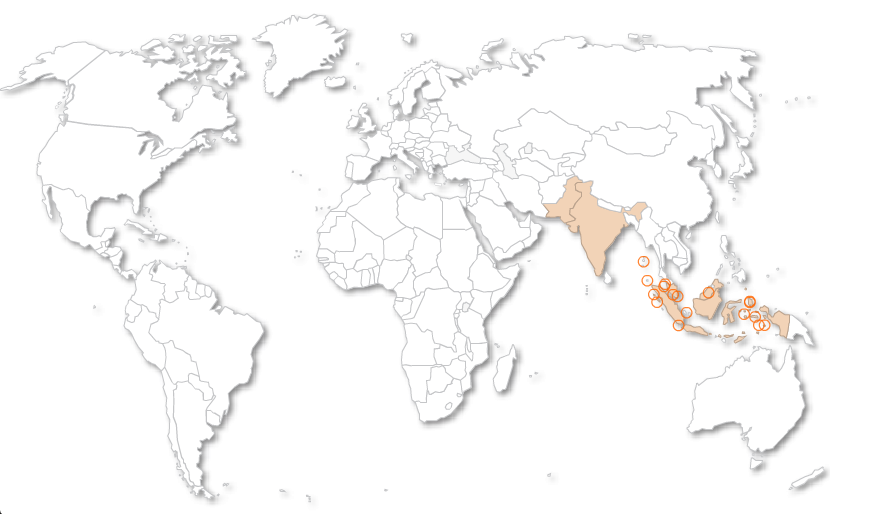
5.2. Habitat
Cosmophasis umbratica are often seen on low vegetation, plants in gardens, and occasionally on tree trunks. Active especially in the morning and evening, this little shiny jumper can be spotted atop of leaves exposed to sunlight. Although not listed as one of the common spiders in Singapore by Joseph K H Koh’s guidebook, it was reported that they are often found associated with the Ixora (Ixora javanica) bush that are planted throughout the island for aesthetic purpose. However, their exact abundance and distribution throughout other regions of Southeast Asia was not well studied and thus remained relatively unknown. Since the Javanese Ixora is a plant native to Southeast Asia, it thus safe to say that their distribution would be somewhat correlated to where this bush is found.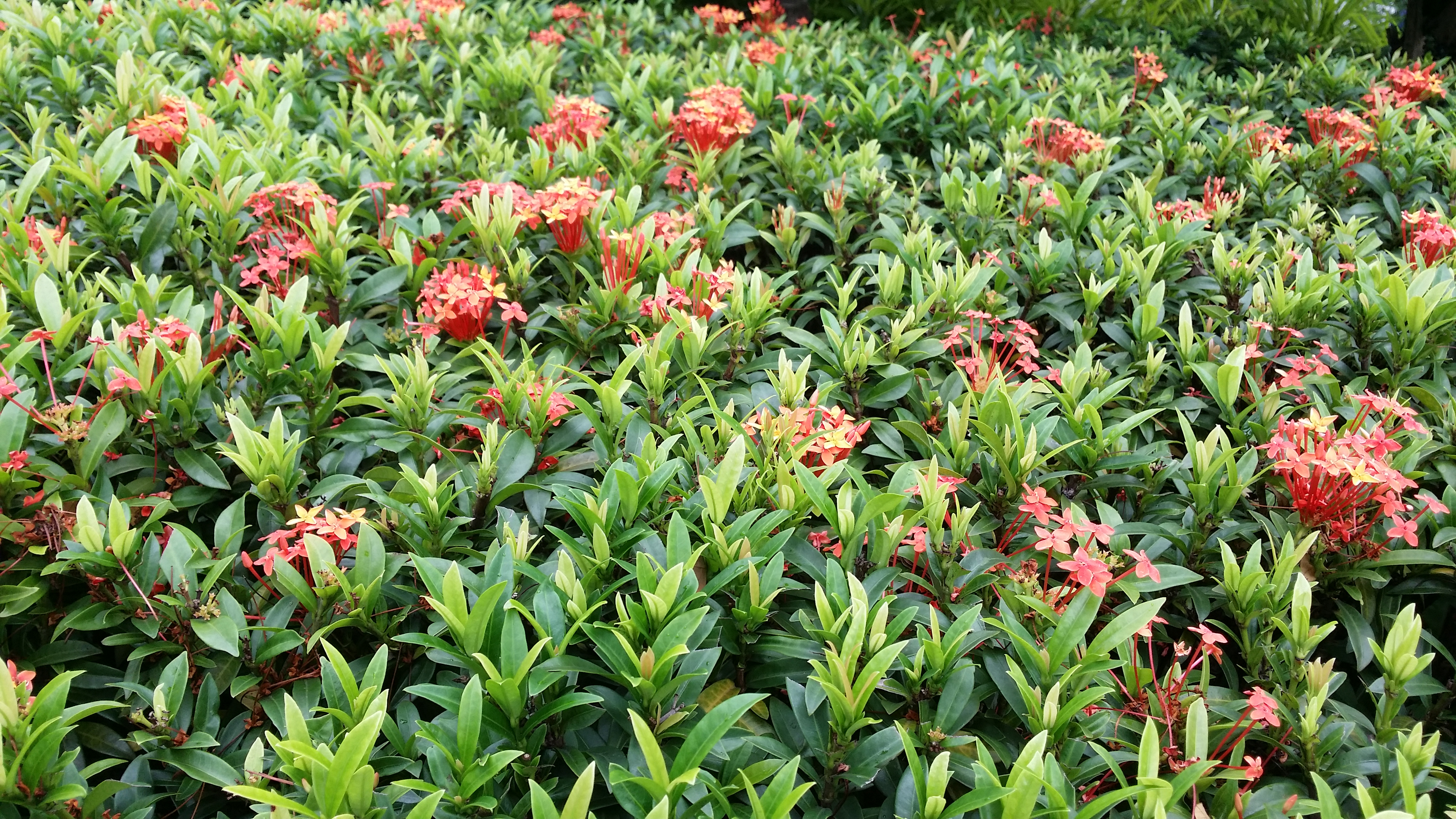
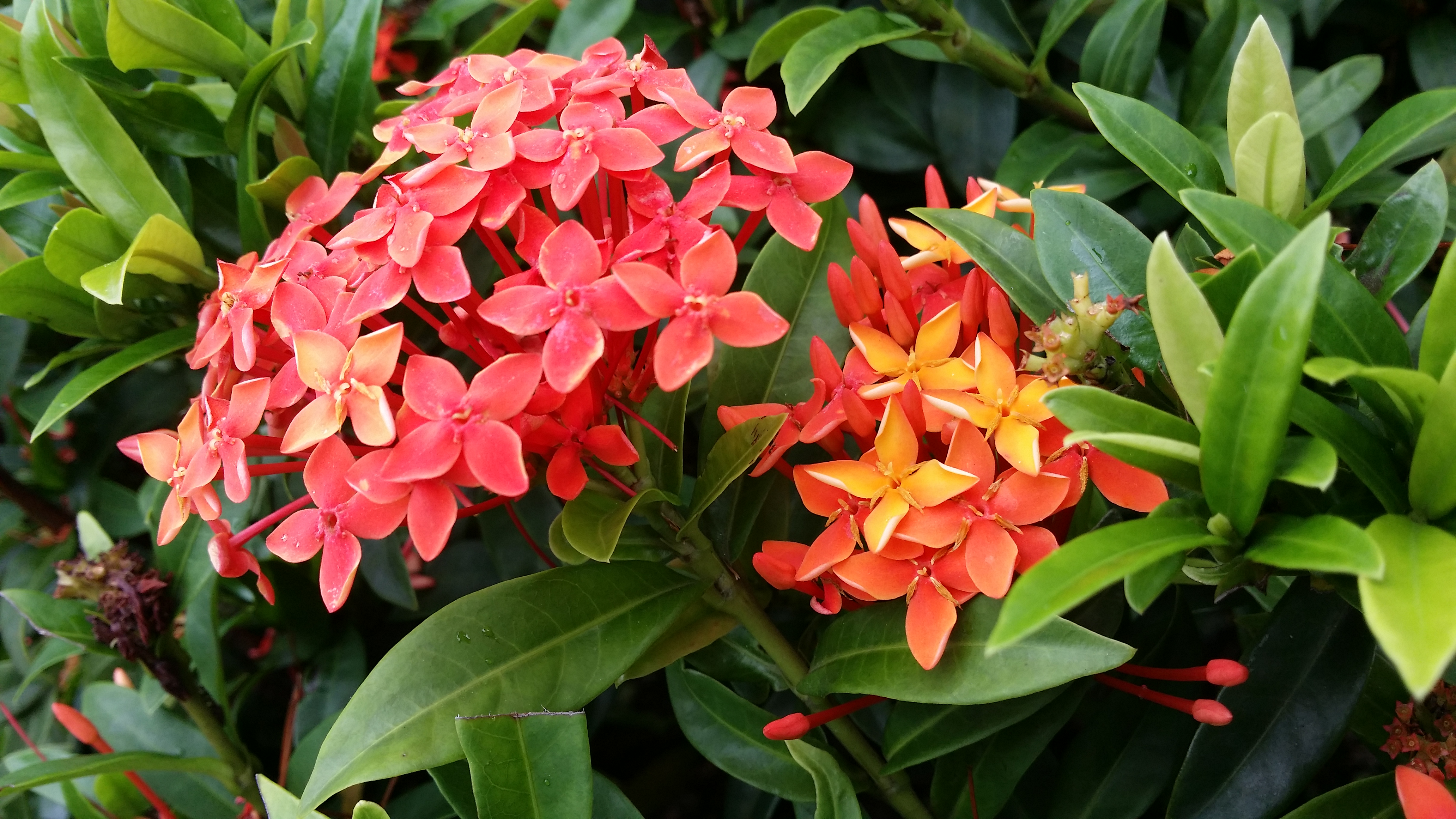
Image 5: A Ixora bush that is commonly found in Singapore (left). A close up photo of the inflorescence of the Ixora plant. (Photo by Rion Huang)
6. Description
Now you know where you can find this little shiny green jumper, you need to how to identify them in the field if you ever spot one.Male and female C. umbratica display sexual dimorphism in both colour and size; males are generally bigger and more brightly coloured as compared to the females.
Research as shown that colourful jumping spiders display structural colouration in which they colour is not likely to fade if well preserved.
6.1 Adult Males
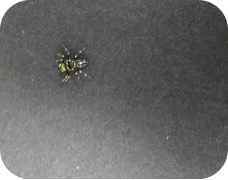 Image 6: A male C. umbratica. Image not to scale. (Photo by Leon Woon) |
Body Length: 5 – 7 mm Colour: dominantly green and black with silvery white markings. Complex iridescent markings on several body regions. Abdomen: Oblong and slender. Legs: Long and slender with iridescent colouration. |
6.2 Adult Females
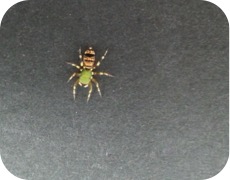 Image 6: A female C. umbratica. Image not to scale. (Photo by Leon Woon) |
Body Length: about 5 mm Colour: Dorsal carapace and side cephalothorax is generally green with a mixture of brown, white and black coloration on the abdomen. Drab looking as compared to males. Not known to display iridescence colouration. Abdomen: Oblong and board, somewhat resembles a rugby ball or Christmas light bulb. Legs: Short as compared to the males with no iridescent colouration. |
6.3 Juvenile
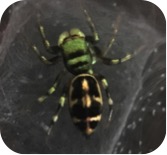 Image 7: A juvenile C. umbtatica. Image not to scale. (Photo by Ivan Liew) |
Lacks iridescence colouration. Sub-adult (sexually immature) males lack a black tip on the tarsi of the palps, and the white hairs on the face are also absent. |
6. 4 Diagnosis
Adult C. umbratica resembles Cosmophasis thalassina to some extent, but can be clearly differentiated from the latter via closer examination of the legs and pedipalps. The colour of the legs of C. umbratica is generally more black and metallic green but for that of C. thalassina is yellowish. The pedipalps for C. thalassina is yellow with black tips but for that of C. umbratica, its white with black tips. Furthermore, the carapace for C. thalassina has a more metallic irridiscent colour as compared to that of C. umbratica.More information on comparing between the jumping spiders please visit salticidae.org
7. Behavioural Biology
As C. umbratica are jumping spiders, they share highly similar behavioral patterns as many salticids. They are highly visual. Both the inter and intra sexual interactions between the spiders has been observed and studied by A/P Li Daiqin.7.1 Locomotions
The movements of C. umbratica can be classified into the following:
|
Video 4: A female Cosmophasis sp. moving on the leaf. Video obtained under fair use. |
7.2 Feeding habits
| Jumping spiders are distinguished from all other spiders by their unique, complex visual system and acute vision, including colour vision, with an extensive spectral sensitivity. Thus, they rely heavily on their acute sense of vision for hunting. They have two sets of eyes: the principal eyes allow them to recognize objects from 20-30 body lengths away while their secondary eyes allow them to detection of long range movement. As such, these spiders have a good field of vision which allows them to capture their prey efficiently and also escape from a predator. They do not spin webs but instead adopt a stalk-and-leap strategy when they encounter their prey. Its because of that they can be said to be like the tigers of the spiders. When they are close enough to their prey, the Salticid will lunge at its prey to capture them and bite them. It is reported that C. umbratica are also nectivorous, sucking on the nectar of the Ixora inflorescence. |
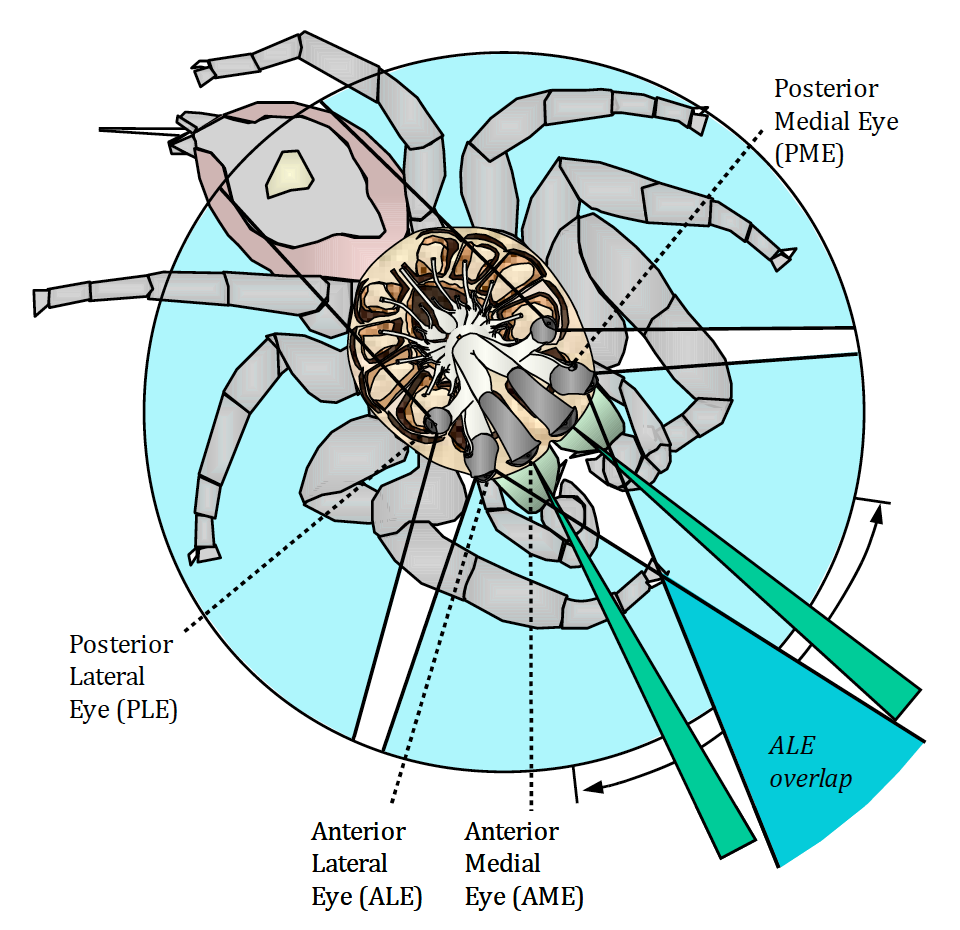 Image 8: Field of vision of a jumping spider. (Image by David Edwin Hill, CC BY 3.0; Source: Wikipedia) |
7.3 Courtship Display
The original description of C. umbratica courtship display is as follows:| "Skittering was the dominant element of the male’s behaviour during male-female interactions. Females usually decamped immediately upon coming into view. There were variations in distance during male and female interactions, from four body lengths to ten body lengths. When the male initially faced the female, the male’s behaviour became noticeably more ‘excited’. He faced the female directly with body raised, abdomen flexed up, legs arched and palps vibrating. If the female did not decamp and instead faced the male, the male then proceeded to skitter with flexed up abdomen and vibrating its palps. Many skittering events, however, resulted in females decamping as males approached. Males however continued to skitter towards the on-looking female if it did not decamp or turn away. Sometimes the male drummed and scraped palps while he postured with flexed up abdomen and arched legs after the female had decamped or had turned away from him. After the female decamped, the male drummed or scraped the substrate only if the female was still in close proximity (about 5 body lengths or less away) and within sight of the male. On some occasions the female bent her abdomen or prodded the male. In a few cases, when the female did not decamp after the male had appeared, she bent her abdomen, and the male either decamped immediately or only after persistent prodding by the female. Occasionally decamped females attempted to run past the male while the males were posturing or in the process of skittering. In these instances, the male normally attempted to block the female by skittering sideways to block her path. Males were never observed to bend their abdomens in any interactions with females, and on few occasions did it follow any females that had decamped or after an unsuccessful blocking. If the female did not decamp, the male postured, skittered and crept towards her with legs I extended, and then mounted. Females always lowered their body prior to mounting and during copulation females might attempt to pull away, though this was seldom observed. Copulation effectively ended with females’ successful attempt to pull away from the male. Duration of copulation was highly variable, but was noticeably longer in copulations involving simultaneous engagements of left and then right palp" - Li Daiqin, 2004 |
7.4 Agonistic Display
As seen in GIF 1, when the males encounter each other, they will engage into a fight.To get a better understanding of this interaction, an abstract from A/P Li's pioneer research on their behaviour is provided below:
| "Male-male agonistic interactions began when one or both spiders started to display (raised bodies, hunched legs, and bent abdomens that were sometimes raised) at about 10-15 cm away. Both males then slowly short skittered towards each other with opened chelicerae (Position 1), vibrating their palps during pauses until they were about 2-3 body lengths apart. One or both spiders then lunged forward with legs elevated (Position 1), chelicerae opened (Position 2) and palps extended (Position 3). After a clash (see Element 29), majority of spiders that were pushed back eventually decamped, and the other spider chased after the decamping spider. If no spiders decamped, what proceeded next depended on size differences between the two males. On two occasions when a smaller male did not decamp after a clash, both males then approached each other with elevated legs (Position 1), opened chelicerae (Position 2) and extended palps (Position 3). Both males attempted to hook and push down each other’s legs, grappled and pushed each other, and eventually the larger male lifted up the smaller male, held it up for about 2 s, and then threw the smaller male, after which the smaller male decamped while the larger male chased it. The duration of conspecific male interactions was generally shorter between males of different sizes than those of similar sizes. When the two males were similar in size, the clash often ended with neither decamping. In these instances, both males then proceeded to extend and retract their legs rapidly. The two males always both performed rapid extending and retracting of legs, but not necessarily simultaneously. While one male was rapidly extending and retracting his legs, the other male sometimes scraped both palps on the substrate. Both spiders often would then raise their bodies as a preliminary to embracing, and then proceeded to elevate their legs (Position 2) so as to hook and push down each other’s legs. Both spiders then grappled and pushed, with chelicerae opened (Position 2) and palps extended (Position 3). The duration of hooking and pushing legs down, grappling and pushing was about 2 s. Eventually one male succeeded in pushing back the other male, often proceeded by a chase after a decamp. " - Li Daiqin, 2004 |
7.5 Nest Building
| Salticids are visual hunters and most are not known to spin webs to capture their prey. Instead, they build nest make of slightly viscid silk for them to retreat into. Cosmophasis umbratica is no exception. The nest constructed by this spider resembles a silken sheet and a tube with entrance on both ends. The sheet was wide at the ends, and narrowed as it approached the doors of the tube. The sheet covered over the silken tube. Males and females built similar nest structures. However, prior to oviposition, the gravid female sealed the doors and remained inside the nest. The nests of C. umbratica were commonly found in-between leaves of Ixora, or at times on the base of the inflorescences. |
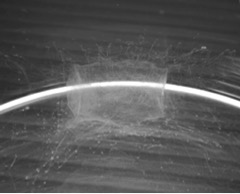 Image 9: A nest of a male C. umbratica (Photo by Matthew Lim) |
8. Taxonomic Information
8.1 Etymology
Cosmophasis is a genus of jumping spiders (Araneae: Salticidae) described by taxonomist Eugène Simon in 1901. It contained 59 known species that occurs mostly in Southeast Asia down to Australia, although some can also be found in Africa. Most of them are ant-mimicking spiders but colourful species such as C. umbratica and C. thalassina are also nested in this genus [cite].The species epithet is derived from Latin umbra, which means 'in the shadows'. This species is frequently found on leaves and flowers on open areas. The exact reason behind its name is unknown but is speculated as a reference to the overall black colouration of the jumping spider, resembling the night shade.
8.2 Type Information & Original Description
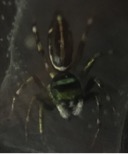 (Photo by Ivan Liew) |
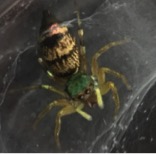 (Photo by Ivan Liew) |
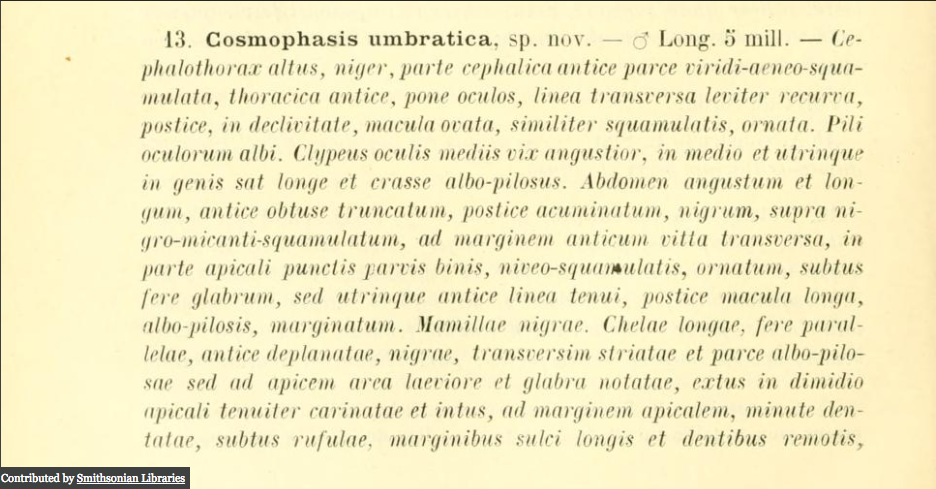
8.3 Taxonavigation
Ordo: Araneae Familia: Salticidae Genus: Cosmophasis| Taxonomic Hierachy |
|
| Kingdom |
Animalia |
| Phylum |
Arthropoda |
| Class |
Arachnida |
| Order |
Araneae |
| Infraorder |
Araneomorphae |
| (unranked) |
Entelegynes |
| Family |
Salticidae |
| Genus |
Cosmophasis Simon 1901 |
| Species |
Cosmophasis umbratica (Simon, 1903) |
8.4 Phylogeny
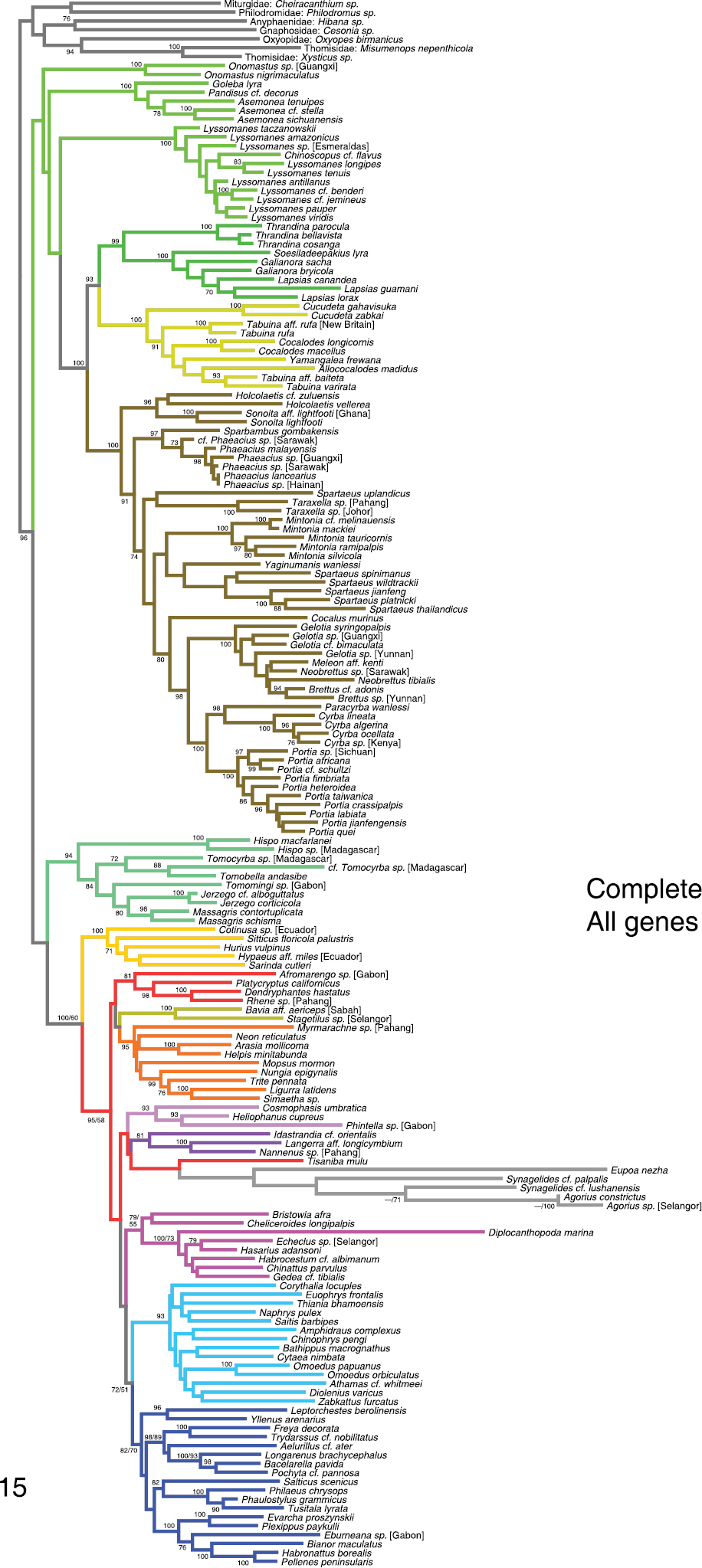
Image 13: A phylogenetic tree of Salticidae.
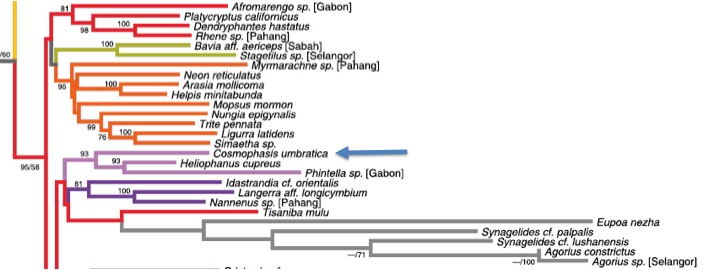
Image 14: A zoom in view of the phylogenetic tree with an arrow pointing to the location of C. umbratica on the tree.
9. Other Significant Findings

Image 15: NUS very own spider man, A/P Li Daiqin looking at a Cosmophasis umbratica inside a petri dish. (Source: The Straits Times, Photo credits:
Chew Seng Kim)
Other than pioneering research on the courtship behaviour of this species of jumping spider, A/P Li also had conducted several following studies about them:
ðHow ultraviolet (UV) cues affect their foraging behaviour
ðBehavioural evidence of UV sensitivity
ðTheir sex-specific UV and fluorescence signals
ðEffects of age and feeding history on structure-based UV ornaments
ðOptics of the ultraviolet reflecting scales
ðEffect of UV-reflecting markings on female mate-choice decisions
ðUV-green iridescence predicts male quality during contests
ðSexually selected UV signals in the tropical ornate jumping spider may incur costs from predation
ðIt takes two peaks to tango: the importance of UVB and UVA in sexual signalling
Other researches done using Cosmophasis umbratica:
Image 16 (removed): A spectrometry study on characterising the degree of polarisation of C. umbratica. This project was conducted by undergraduates who took LSM4267 (Animal Communication and Sensory Ecology) module in NUS, under the supervision of Dr. Matthew Lim. (Photo by Rion Huang & Leon Woon)
Image 17 (removed): Another project undertaken by undergraduates who took the LSM4267 module in NUS, under the supervision of Dr. Matthew Lim. This study looks into how varying the polarised light affects the nest building behaviour of C. umbratica. (Photo by Ivan Liew, Lim Zhi Yun and Tan Li Ting)
10. Literature & References
Relevant published studies by A/P Li Daiqin (in chronological order)[1] Li, D. (2002). A checklist of spiders from Singapore (Arachnilla: Araneae). The Raffles Bulletin of Zoology, 50(2), 359-388.
[2] Lim, M. L., & Li, D. (2004). Courtship and male-male agonistic behaviour of Cosmophasis umbratica Simon, an ornate jumping spider (Araneae: Salticidae) from Singapore. Raffles Bulletin of Zoology, 52(2), 435-448.
[3] Li, D., & Lim, M. L. (2005). Ultraviolet cues affect the foraging behaviour of jumping spiders. Animal Behaviour, 70(4), 771-776.
[4] Lim, M. L., & Li, D. (2006). Behavioural evidence of UV sensitivity in jumping spiders (Araneae: Salticidae). Journal of Comparative Physiology A, 192(8), 871-878.
[5] Lim, M. L., Land, M. F., & Li, D. (2007). Sex-specific UV and fluorescence signals in jumping spiders. Science, 315(5811), 481-481.
[6] Lim, M. L., & Li, D. (2007). Effects of age and feeding history on structure-based UV ornaments of a jumping spider (Araneae: Salticidae). Proceedings of the Royal Society of London B: Biological Sciences, 274(1609), 569-575.
[7] Land, M. F., Horwood, J., Lim, M. L., & Li, D. (2007). Optics of the ultraviolet reflecting scales of a jumping spider. Proceedings of the Royal Society of London B: Biological Sciences, 274(1618), 1583-1589.
[8] Lim, M. L. M. (2007). UV Vision in Jumping Spiders (Araneae: Salticidae): Sexual Selection and Foraging Behaviour (Doctoral dissertation, PhD thesis
Under the supervision of A/P Li Daiqin, National University of Singapore).
[9] Lim, M. L., Li, J., & Li, D. (2008). Effect of UV-reflecting markings on female mate-choice decisions in Cosmophasis umbratica, a jumping spider from Singapore. Behavioral Ecology, 19(1), 61-66.
[10] Norma-Rashid, Y., & Li, D. (2009). A checklist of spiders (Arachnida: Araneae) from Peninsular Malaysia inclusive of twenty new records. The Raffles Bulletin of Zoology, 57(2), 305-322.
[11] Lim, M. L., & Li, D. (2013). UV-green iridescence predicts male quality during jumping spider contests. PloS one, 8(4), e59774.
[12] Maddison, W. P., Li, D., Bodner, M., Zhang, J., Xu, X., Liu, Q., & Liu, F. (2014). The deep phylogeny of jumping spiders (Araneae, Salticidae). ZooKeys, 440, 57–87.
[13] Bulbert, M. W., O'Hanlon, J. C., Zappettini, S., Zhang, S., & Li, D. (2015). Sexually selected UV signals in the tropical ornate jumping spider, Cosmophasis umbratica may incur costs from predation. Ecology and evolution, 5(4), 914-920.
[14] Painting, C. J., Rajamohan, G., Chen, Z., Zeng, H., & Li, D. (2016). It takes two peaks to tango: the importance of UVB and UVA in sexual signalling in jumping spiders. Animal Behaviour, 113, 137-146.
Other relevant publications
[15] Simon, E. (1903h). Etudes arachnologiques. 34e Mémoire. LIV. Arachnides recueillis à Sumatra par M. J. Bouchard. Annales de la Société Entomologique de France 72: 301-310.
[16] Dyal, S. (1935). Fauna of Lahore. 4.--Spiders of Lahore. Bulletin of the Department of Zoology of the Panjab University 1: i-ii, 119-252.
[17] Koh, J. K. H., (1991). Spiders of the family Araneidae in Singapore mangroves. The Raffles Bulletin of Zoology. 39(1): 169-182.
[18] Taylor, L. A., Clark, D. L., & McGraw, K. J. (2014). Natural variation in condition-dependent display colour does not predict male courtship success in a jumping spider. Animal Behaviour, 93, 267-278.
[19] Taylor, L. A., & McGraw, K. J. (2013). Male ornamental coloration improves courtship success in a jumping spider, but only in the sun. Behavioral Ecology, art011.
[20] Corcobado, G., Herberstein, M. E., & Pekár, S. (2016). The role of ultraviolet colour in the assessment of mimetic accuracy between Batesian mimics and their models: a case study using ant-mimicking spiders. The Science of Nature, 103(11-12), 90.
[21] Caleb, J. T., & Karthikeyani, R. (2015). A new jumping spider of the genus Cosmophasis Simon. Acta Arachnologica, 64(2), 97-99.
[22] SEAH WEI HOU, S. T. A. N. L. E. Y. (2010). The adaptive significance of UV reflectance in the jumping spider, Cosmophasis umbratica (araneae: salticidae) (Doctoral dissertation).
[23] Morehouse, N. I., Vukusic, P., & Rutowski, R. (2007). Pterin pigment granules are responsible for both broadband light scattering and wavelength selective absorption in the wing scales of pierid butterflies. Proceedings of the Royal Society of London B: Biological Sciences, 274(1608), 359-366.
Online references
[24] Wikipedia page on Cosmophasis umbratia [link]
[25] Wikipedia page on jumping spiders [link]
[26] Tierdoku page (in German) on Cosmophasis umbratica [link]
[27] Sokół, M. & Prószyński, J. (2016). Monograph of Salticidae (Araneae) of the World 1995-2015. Part II: Global Species Database of Salticidae (Araneae). Retrieved 20th Nov 2016 from http://www.peckhamia.com/salticidae/index.html
[28] Metzner, H. (2015) Cosmophasis umbratica (♂,♀) SIMON, 1903. Worldwide database of jumping spiders (Arachnida, Araneae, Salticidae). Retrieved 20th Nov 2016 from http://www.jumping-spiders.com/index_wiki.php?id=1092
[29] Tan, A. (2016). Close encounters of the crawly kind. The Straits Times. Singapore Press Holdings. Retrieved 20th Nov 2016 from http://www.straitstimes.com/singapore/close-encounters-of-the-crawly-kind
11. Personal Communications / Acknowledgements
Dr. Matthew Lim Lek Min, Department of Biological Sciences, National University of Singapore.A/P Li Daiqin, Department of Biological Sciences, National University of Singapore.
Mr. Leon Woon Wei Jie, Mr. Liew Zhiying Ivan
12. Additional Notes
Information found on this page may not be comprehensive, for any additional new findings, feel free to contact me and I will update accordingly.Image 16 and 17 (research posters) has been taken down due to request as it consist of publishable data. Should you wish you find out more about the researches done, please kindly contact Dr. Matthew Lim personally.
13. Contact
Rion HuangLast updated: 5 Mar 2017
| Subject | Author | Replies | Views | Last Message |
|---|---|---|---|---|
| No Comments | ||||